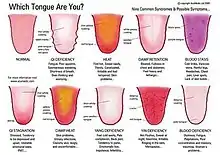Tongue diagnosis in Chinese Medicine is a method of diagnosing disease and disease patterns by visual inspection of the tongue and its various features. It is one of the major diagnostic methods in Chinese Medicine since the time of the Yellow Emperor's Inner Classic.[1] It is considered a part of the “Inspection” method within the four methods of diagnosis.[2] Practitioners claim that the tongue provides important clues reflecting the conditions of the internal organs. Like other diagnostic methods in Traditional Chinese Medicine, tongue diagnosis is based on the “outer reflects the inner” principle, which is that external structures often reflect the conditions of the internal structures and can give us important indications of internal disharmony.[2]

Topography of the Tongue
The tongue is divided into topographic regions corresponding to the Triple Burner and Zang Fu organs.[1] By observing the various regions of the tongue, one can determine where the disease is located within the body.
One method of mapping the tongue is by dividing it into three sections to correspond to the Triple Burner. The tip of the tongue corresponds to the Upper Burner (Heart, Lungs); the middle corresponds to the Middle Burner (Stomach, Spleen), and the base of the tongue corresponds to the Lower Burner (Kidneys, Bladder, Intestines).[1]
Another method is to map the tongue by Zang Fu organs. The tip of the tongue corresponds with the Heart, the region at the front of the tongue between the tip and the center corresponds to the Lung, the center corresponds with Stomach and Spleen, the right side corresponds to the Gallbladder, the left side corresponds to the Liver, and the base of the tongue corresponds to Kidney, Bladder, Large Intestine, and Small Intestine.[1]
The mapping of organs to areas of the tongue in Chinese Medicine hold correlation with mapping of the reflex zones of the tongue in ancient Greek medicine.
Aspects of the Tongue
The aspects of the tongue considered in diagnosis include:
- Tongue spirit or vitality
- Body color
- Body shape
- Tongue coating
- Tongue moisture
In addition, various features are also considered, including absence or presence of and the characteristics of movement, bristles, cracks, and teethmarks.[1]
Normal tongue
A normal, healthy tongue is pale red or pink with a thin white coating. The tongue should have spirit, but it should not tremble or quiver. It should have a shape which is not too swollen or flabby, with no cracks, and be slightly moist.[1]
Significance of the Tongue in Diagnosis
When differentiating between various patterns in clinical settings, tongue diagnosis plays a significant role. In a situation in which a patient has complex or even conflicting clinical presentations, the tongue body color nearly always reflects the true underlying condition.[1] For example, a patient may present with various localized signs of Heat, however, the tongue may reflect an underlying condition of Cold from Yang deficiency. In this case it is important to consider the underlying condition in the treatment principle.[1]
Scientific evaluation
A 2008 study found that interpractitioner and intrapractitioner reliability levels were low.[3] The features of the tongue are claimed to be tied to specific body parts, but evidence is lacking.[4]
See also
References
- 1 2 3 4 5 6 7 8 Maciocia, Giovanni (1995). Tongue Diagnosis in Chinese Medicine. Eastland Press. ISBN 978-0-939616-19-0.
- 1 2 Maciocia, Giovanni (2015). "Tongue". The Foundations of Chinese Medicine: A Comprehensive Text. Elsevier Health Sciences. pp. 324–331. ISBN 978-0-7020-5216-3.
- ↑ Kim, Minah; Cobbin, Deirdre; Zaslawski, Christopher (June 2008). "Traditional Chinese Medicine Tongue Inspection: An Examination of the Inter- and Intrapractitioner Reliability for Specific Tongue Characteristics". The Journal of Alternative and Complementary Medicine. 14 (5): 527–536. doi:10.1089/acm.2007.0079. PMID 18564955.
- ↑ Hall, Harriet (26 December 2017). "A Misguided Study to Test the Reliability of Traditional Chinese Medicine Pulse Diagnosis". Science-Based Medicine.
Further reading
- Anastasi, Joyce K.; Chang, Michelle; Quinn, Jessica; Capili, Bernadette (1 February 2014). "Tongue Inspection in TCM: Observations in a Study Sample of Patients Living with HIV". Medical Acupuncture. 26 (1): 15–22. doi:10.1089/acu.2013.1011. PMC 3929461. PMID 24761186.
- Gareus, Isabel; Rampp, Thomas; Tan, Linda; Lüdtke, Rainer; Niggemeier, Corinna; Lauche, Romy; Klose, Petra; Dobos, Gustav (2014). "Introducing a Computer-Assisted, Digital Tongue- Imaging Device for Standardization of Traditional Tongue Diagnosis". Forschende Komplementärmedizin. 21 (3): 190–6. doi:10.1159/000365019. PMID 25060159. S2CID 2732800.
- Kawanabe, Tadaaki; Kamarudin, Nur Diyana; Ooi, Chia Yee; Kobayashi, Fuminori; Mi, Xiaoyu; Sekine, Mariko; Wakasugi, Akino; Odaguchi, Hiroshi; Hanawa, Toshihiko (December 2016). "Quantification of tongue colour using machine learning in Kampo medicine". European Journal of Integrative Medicine. 8 (6): 932–941. doi:10.1016/j.eujim.2016.04.002.
- Kim, Jinsung; Han, Ga-Jin; Choi, Bin-Hye; Park, Jae-Woo; Park, Kyungmo; Yeo, In-Kwon; Ryu, Bong-Ha (October 2012). "Development of differential criteria on tongue coating thickness in tongue diagnosis". Complementary Therapies in Medicine. 20 (5): 316–322. doi:10.1016/j.ctim.2012.03.004. PMID 22863646.
- Lo, Lun-chien; Chen, Yung-Fu; Chen, Wen-Jiuan; Cheng, Tsung-Lin; Chiang, John Y. (2012). "The Study on the Agreement between Automatic Tongue Diagnosis System and Traditional Chinese Medicine Practitioners". Evidence-Based Complementary and Alternative Medicine. 2012: 505063. doi:10.1155/2012/505063. PMC 3424603. PMID 22924055.
- Lo, Lun-Chien; Cheng, Tsung-Lin; Chiang, John Y.; Damdinsuren, Natsagdorj (July 2013). "Breast Cancer Index: A Perspective on Tongue Diagnosis in Traditional Chinese Medicine". Journal of Traditional and Complementary Medicine. 3 (3): 194–203. doi:10.4103/2225-4110.114901. PMC 3924992. PMID 24716178.
- Lo, Lun-Chien; Chen, Chia-Yun; Chiang, John Y; Cheng, Tsung-Lin; Lin, Hong-Jen; Chang, Hen-Hong (12 August 2013). "Tongue Diagnosis of Traditional Chinese Medicine for Rheumatoid Arthritis". African Journal of Traditional, Complementary and Alternative Medicines. 10 (5): 360–369. doi:10.4314/ajtcam.v10i5.24. PMC 3847431. PMID 24311851.
- Lo, Lun-chien; Cheng, Tsung-Lin; Chen, Yi-Jing; Natsagdorj, Sainbuyan; Chiang, John Y. (October 2015). "TCM tongue diagnosis index of early-stage breast cancer". Complementary Therapies in Medicine. 23 (5): 705–713. doi:10.1016/j.ctim.2015.07.001. PMID 26365451.
- Tania, Marzia Hoque; Lwin, Khin; Hossain, Mohammed Alamgir (2019). "Advances in automated tongue diagnosis techniques". Integrative Medicine Research. 8 (1): 42–56. doi:10.1016/j.imr.2018.03.001. PMC 6428917. PMID 30949431.